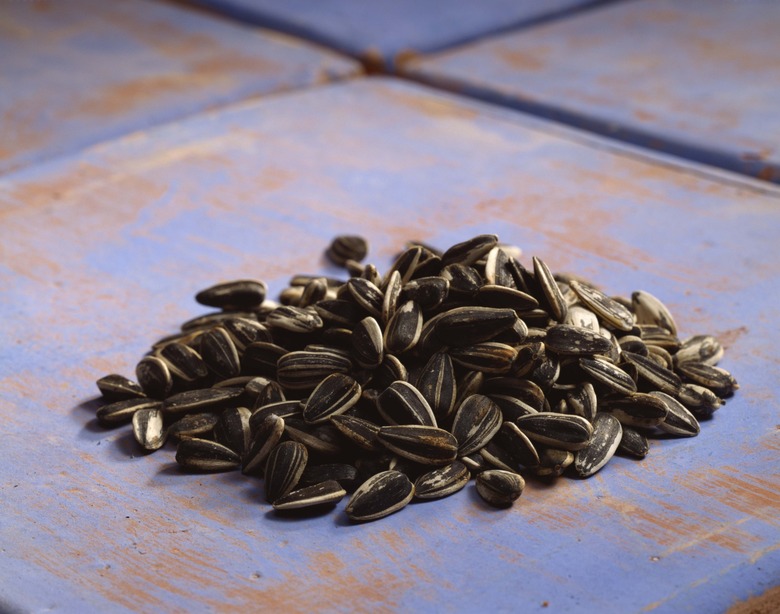Uses For Sunflower Seed Shells
Sunflower seeds are a nutritious snack that grow in the center of a bright yellow sunflower. A black and white hull, or seed shell, encases sunflower seeds. Unfortunately, the hull of the sunflower seed is not edible, but it has other uses. In addition to providing food for humans and birds, uses of sunflower byproducts include cooking oil, biodiesel fuel and medicine. Construction and agriculture industries make use of sunflower seed shells rather than discarding them. Using a natural, renewable resource such as sunflower seed shells has a lower impact on the environment than depleting slow-forming resources like trees to serve the same purpose.
Sunflower Seed Shells as Mulch
Sunflower Seed Shells as Mulch
Sunflower seed shells are _allelopathic_, which means that they produce a chemical that inhibits the growth of plants around them. This property makes sunflower seed shells well suited for use as mulch in established gardens and flower beds because of their ability to suppress weeds. Sunflower seed shells can also be used to mulch garden paths and walkways.
If you have sunflower seeds in your bird feeder, you no doubt have a stockpile of discarded hulls on the ground around the feeder. Gather the hulls and add a layer of the sunflower seed shells around your plants to prevent weed growth, leaving a few inches around plant stalks so the shells don't also inhibit the growth of your flowers.
Allelopathy in sunflower seed shells unfortunately means that the hulls are not proper candidates for a compost pile: Organic matter in compost piles should break down to support plant growth rather than inhibit growth.
Construction Products Made of Shells
Construction Products Made of Shells
Sunflower seed shells have made their way into the construction trade in the form of Dakota Burl, a natural-fiber wood paneling made from discarded sunflower seed shells. The wood panels feature a swirled mixture of light and dark colors – the same colors commonly found in a sunflower seed shell.
The wood presents an environmentally friendly alternative to other wood products because sunflower seed shells are renewable, recycled waste products instead of wood produced from ancient, harvested trees. The panels are typically four feet by eight feet and vary in thickness from one-half inch to one inch, and are intended for both horizontal and vertical use.
Workers cut, sand, stain and paint Dakota Burl in the same manner as other wood products. Common applications include wall paneling, cabinetry, furniture and even award plaques.
Hulls as Animal Feed
Hulls as Animal Feed
Sunflower seed shells can be used to feed ruminants – including cattle and sheep – providing roughage in their rations. The hulls are comprised of ash, crude protein, lipid material, reducing sugars and carbohydrates. Although low in protein and nutritional value, the high fiber and carbohydrate content of the hulls make them well suited for animal feed when mixed with ingredients with higher nutritional value.
The hulls absorb liquid ingredients in feed and serve as a filler ingredient. Hulls must be finely ground in the feed for easier digestion. Grind your own hulls for animal feed if you have a surplus of sunflower seed shells, or sell them to a local ruminant feed manufacturer. Sunflower seed shells can also be used as bedding material for livestock.
Fuel from Sunflower Seed Shells
Fuel from Sunflower Seed Shells
With a heat value of 19.2 megajoules per kilogram, sunflower seed shells are commonly used as a fuel source. The hulls can be burned by themselves or pressed into pellets, bricks or fuel logs along with other organic waste products, like straw, coconut shells or sawdust.
Renewable resources like sunflower seed hulls have less of an impact on the environment than burning wood logs and are generally more affordable than heating with fossil fuels. For example, Barnesville High School in Minnesota uses sunflower hulls to heat the entire school. The school uses between 450 and 600 tons of sunflower pellets in a single heating season.
Cite This Article
MLA
Allonsy, Amelia. "Uses For Sunflower Seed Shells" sciencing.com, https://www.sciencing.com/uses-for-sunflower-seed-shells-12588918/. 30 September 2021.
APA
Allonsy, Amelia. (2021, September 30). Uses For Sunflower Seed Shells. sciencing.com. Retrieved from https://www.sciencing.com/uses-for-sunflower-seed-shells-12588918/
Chicago
Allonsy, Amelia. Uses For Sunflower Seed Shells last modified March 24, 2022. https://www.sciencing.com/uses-for-sunflower-seed-shells-12588918/
